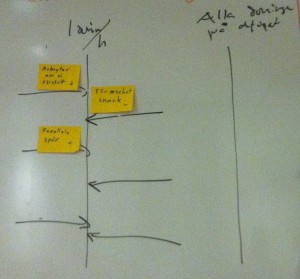Great retrospectives are amazing, they have a way of really getting a team to work together and to energize them ahead of a new challenge. But even a great retrospective becomes boring and routine after a while. Luckily, there are a lot of us at Crisp working with different teams, so we got together this evening for a peer to peer exchange about retrospectives. We each got to pitch retrospective exercises and games that we’d like to try, or that we wanted to share. We ended up discussing and trying out 9 of them. Here’s a summary in case you’d like to try some of them out at your next retrospective!

 Non Musical Chairs (http://tastycupcakes.org/2011/04/non-musical-chairs/)
Non Musical Chairs (http://tastycupcakes.org/2011/04/non-musical-chairs/)
To setup this game place chairs around the room, the idea is to have a chair per team member plus one extra chair. Each person takes a seat (one chair remains empty), and for a minute they are supposed to stop the facilitator from sitting on the empty chair by moving around. We failed within the first few seconds the first time, then we had a short retrospective and tried again, and again, and again… The game suggests that after several iterations the team will successfully keep the facilitator standing for the whole minute. After 25 minutes and several iterations we still hadn’t reached a solution. While it was a fun physical activity, it was pretty frustrating agile learning activity. To make this game more meaningful, in a shorter amount of time, we came up with the following suggestions:
- Let the goal be to lengthen the time that you keep the facilitator off a chair (we were improving our time, so this seemed more reasonable than fixating on a 1 minute goal)
- Run a meta-retrospective. What worked, and didn’t work when we worked together to improve our performance.
The Chair Game
Since we had already cleared the room for the previous exercise we squeezed in an unplanned game. We split up into three teams. Each team got a written instruction. We were supposed to try to complete our objective without talking to anyone else during the game, and without knowing what the other teams’ objectives were. The instructions:
- Team 1 : Place all the chairs in a circle
- Team 2 : Place all the chairs back to back
- Team 3: Place all the chairs upside down
It was a bit chaotic at first, but once one person figured it out it quickly spread to the others, and within a couple of minutes we had all the chairs in a circle, back to back and upside down. To get the most of the game there should be some discussion afterwards on what happened and how we got to a working solution.

We tested this exercise with the real life problem we were facing at the RD, our velocity was approximately 1 exercise/hour and we had more than 20 suggested exercises on the board. So we set our desired outcome: by the end of the RD we would cover all of the exercises in depth, and worked on seeing how we could get there and what was stopping us.
We split up into teams to come up with three forces that help push us towards our desired outcome, and three forces that push us away. The first team to present suggested that we should stop explaining an exercise once everyone felt they understood. We all thought that this was such a good positive force that we ended this exercise right then and there.
This is a good exercise to help a team generate insight.
This was a really nice and fast idea for getting a feel for how the team is doing over time.
The team rates the following example questions on a scale of 1 to 9 (1 being really bad, and 9 being exceptional) :
- How fun was the sprint?
- How do you rate your performance?
- How do you rate the team’s ability to meet the sprint goal?
- Did we have a the right pre-conditions going into the sprint after the planning?
- How was your ability to focus during the sprint?
You use a spread sheet to calculate the averages, and then keep a running graph for the team. There was a suggestion to ask question 4 (did we have the right pre-conditions going into the sprint) right after the planning meeting and comparing the results. This exercise is also good for revealing issues, and getting everyone on track for the rest of the retrospective.
We didn’t actually try this exercise out, since it takes quite a while. Instead we just got a walk through the rules. The idea is that each person sets up a “market stall” with the skills that they have that can help the team achieve their goals, they also list the skills that they have that may not directly be helpful to the goals. The other team members then can respond with what they think that person is good at. This exercise helps teams identify who on the team is good at what, it also helps team members see how they are perceived by the others.
This game moved way too fast.. and we missed the point entirely. We split up into pairs and each person 5 cards from a planning poker deck. We each had the same cards 0,1,2,3,5. Each person got to place one card face down, we then flipped the cards over at the same time. The object was to select all five cards in the same order without talking to the other person. The idea was to then combine the pairs that had succeeded and try to get all four people to select the cards in the same order, etc.
It took us just a couple of minutes to run through this exercise.. Without prior agreement we all happened to flip the cards over in ascending order in all the pairs. There was absolutely no challenge. The object of the game is to get teams to understand the importance of communication and coordination, and to help them understand why you would want to have the meetings that scrum prescribes by discussing how the game played out. To improve this game so that it meets the objective our suggestion is to use cards that don’t have a natural order, maybe pictures of the team members, or colors, or fruit. I’m not sure I would try this one out on a real team before testing it again on some willing volunteers..
Multitasking Card Game
This was a great way to illustrate how disturbances and multitasking can drastically, negatively affect velocity. The objective was to count as many cards as possible out loud from three different piles of cards in 30 seconds. Our volunteer worked undisturbed on his first run, he managed to go through almost two piles and counted 91 cards. On the second run he got some really simple questions every few seconds, that he was obliged to answer (e.g. what is your name) and he only managed to count about 30 cards. On the third run he was told that all three piles were equally important to count, and that he should count each pile for only five seconds at a time. He did well for the first five seconds, getting up to 18, but then managed to count only up to about 30 by the end.
Agile Values
Helps the teams recognize which values they need to improve on. The team is split into groups of 2-3 and get handed a set of agile values (e.g. build quality in). They are asked to rank each value on a scale from “strongly disagree” to “strongly agree”. Once all the data is collected from all the teams, they are asked to now rate each one based on how well the team lives up to this value from “poor” to “excellent”. Combining the two results you get a good idea of the values that are rated highly by the team, but that are implemented poorly, and a starting point for a discussion. We discussed the possibility of phrasing some of the values negatively so that some values could get lower scores, or letting the team themselves come up with their own values.
ROTI

Our final exercise was to run a retrospective for the RD in 10 minutes. The suggestion was to use ROTI – return on time invested. This is by far one of my most favorite retrospective exercises because you get good feedback quickly.
So on a scale from 0 to 4 we got to rate the 3 hour RD. 2 means: that it was worth the three hours invested. 1: that you could have spent the time better, but you still got something out of the presentation. 0: that pretty much anything would have been better time spent. 3: that you got more value for your time. 4: that there was no better way for you to spend your time than at this meeting.
We all got up and rated our time investment, then those who voted the lowest scores discussed why the didn’t vote higher (the minuses) then the whole group discussed how to improve this meeting if we were to do it again (the pluses). Some of the pluses just stated that we should keep doing some of the things we did, while others suggested changes. An ROTI with an average score higher than 3 is a great thing! Thanks to everybody who participated!
I hope that the blog summary is helpful to you in adding something new to your retrospectives! Want even more suggestions? The site
http://tastycupcakes.org/ has a huge listing of agile games and the book
Gamestorming was highly recommended.
Get in touch via my homepage if you have questions or comments!
 Non Musical Chairs (http://tastycupcakes.org/2011/04/non-musical-chairs/)
Non Musical Chairs (http://tastycupcakes.org/2011/04/non-musical-chairs/) We tested this exercise with the real life problem we were facing at the RD, our velocity was approximately 1 exercise/hour and we had more than 20 suggested exercises on the board. So we set our desired outcome: by the end of the RD we would cover all of the exercises in depth, and worked on seeing how we could get there and what was stopping us.
We tested this exercise with the real life problem we were facing at the RD, our velocity was approximately 1 exercise/hour and we had more than 20 suggested exercises on the board. So we set our desired outcome: by the end of the RD we would cover all of the exercises in depth, and worked on seeing how we could get there and what was stopping us. Our final exercise was to run a retrospective for the RD in 10 minutes. The suggestion was to use ROTI – return on time invested. This is by far one of my most favorite retrospective exercises because you get good feedback quickly.
Our final exercise was to run a retrospective for the RD in 10 minutes. The suggestion was to use ROTI – return on time invested. This is by far one of my most favorite retrospective exercises because you get good feedback quickly.



Thanks for the writeup! It was a fun evening!
It really was 🙂
Nice activities, I wonder how we can play these with distributed teams?
Great job – thx for summarizing so many options for retro’s incl. useful hints. I didn’t find a comparable comprehensive page on this – even it is from 2012 🙂
Glad it was useful!